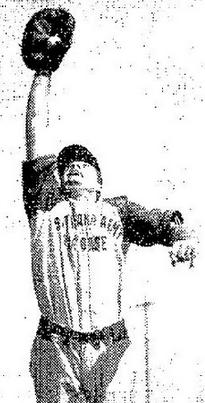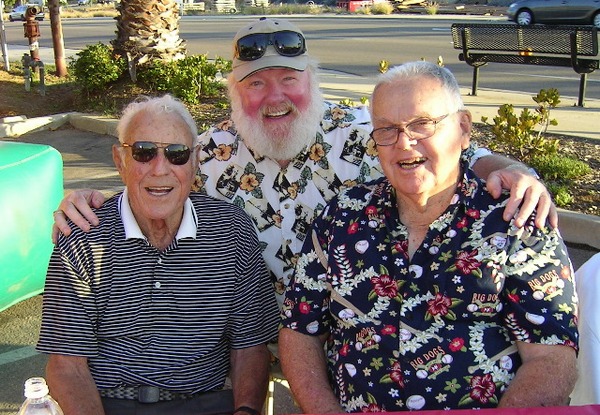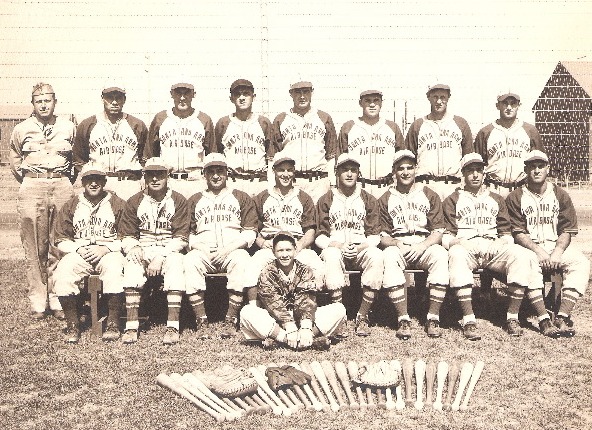

Dick Adams
Date and Place of Birth: April 8, 1920 Tuolumne, California
Baseball
Experience:
Major League
Position: First Base
Rank: Staff Sergeant
Military Unit: USAAF
Area Served: United States
Major League Stats: Dick Adams on Baseball-Almanac
 Richard L “Dick” Adams was born on April 8, 1920 in Tuolumne,
California. He came from a
musical family and his father wanted him to be a classical musician
- although he preferred jazz.
Richard L “Dick” Adams was born on April 8, 1920 in Tuolumne,
California. He came from a
musical family and his father wanted him to be a classical musician
- although he preferred jazz.
But instead, he signed a professional baseball contract for Cincinnati Reds along with his brother Bobby and was assigned to the Ogden Reds in the Class C Pioneer League in 1939. In 1940 he played with Tucson Cowboys and the Albuquerque Cardinal, in the Class D Arizona-Texas League.
"I do remember that the Air Corps flew us around to play other bases to raise morale. Of course, everybody wanted to see Joe play. We flew up to Ogden and Salt Lake City, but I remember Tucson the best. I went four-for-four off Bill Clemensen who pitched for the Pirates. We stayed at the St. Rita Hotel. They had an elevator with an operator. You remember how they used to have elevator operators. She wore a uniform and was a good looking gal. She recognized Joe and stopped the elevator between floors. It was just her, Joe, me and my brother Bobby in the elevator. She said, 'Mr. DiMaggio, I can make you forget your wife.' Joe had just gotten divorced from his wife the actress Dorothy Arnold. Joe shook his head. Bobby and I said, 'What about us?' She said, 'No!'
|
|
|
Santa Ana Army Air Base in 1943. Dick Adams is back row, sixth left. His brother Bobby is front row, fourth left and Joe DiMaggio is front row, seventh left. |

In December 1945 Staff Sergeant Adams was mustered out of service. Adams hit .330 and drove in 155 runs for the Wenatchee Chiefs of the Class B Western International League in 1946 and in November of that year was drafted by the Philadelphia Athletics. On May 20, 1947, Dick Adams made his major league debut with Philadelphia. He remained with the club for the 1947 season, appearing in 37 games and batting .202 with two home runs.
He was back in the minor leagues in 1948 where he continued to play until 1953. His brother, Bobby, was an infielder with the Reds, White Sox, Orioles and Cubs from 1946 to 1959. His nephew, Mike, Bobby’s son, was an outfielder with the Twins, Cubs and Athletics during the 1970s.
"After I finished playing and managing in pro ball, I was a basketball coach, baseball coach and athletic director in the Whittier Union High School District for 26 years," he told Bill Swank. "I'm 87 years old and still play golf, but had to give up tennis in my early 80s because my knees gave out. I also play Big Band music several times a week with a group for senior dances, but jazz is still my favorite."
 |
| Herm Reich, Bill Swank and Dick Adams on July 20, 2007 |
Thanks to Bill Swank for sharing the transcript of his great interview with Dick Adams. Thanks to Dick Adams for many of the photos.
Created July 17, 2007. Updated July 31, 2007.
Copyright © 2015 Gary Bedingfield (Baseball in Wartime). All Rights Reserved.
